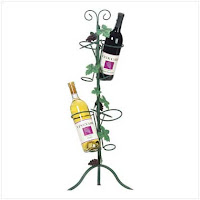
Understanding proper wine storage helps determine the wine rack or wine cabinet that's right for you. Store wine horizontally. When it comes to storing wine, let it lie. Whether white or red wine, select a wine rack or wine cabinet that accommodates the bottles of wine lying on their side. This allows the cork to maintain moisture and the sediment to collect on the bottom of the bottle.
Showcase Your Handsome Wine Rack or Wine Cabinet Of course, you will want to
 display your new, beautiful wine rack wine cabinet in a prominent place in the home. But when selecting the location of your focal point, keep two key environmental factors in mind: light and temperature. Unable to keep things cool, but still want to store and display your wine? Don't aim for long-term storage if warmer temperatures are unavoidable Select and store wine you plan to enjoy in six months or less. And be sure to chill both red and white wines before serving. Even a red wine should be brought down from room temperature to 60 degrees before serving.
display your new, beautiful wine rack wine cabinet in a prominent place in the home. But when selecting the location of your focal point, keep two key environmental factors in mind: light and temperature. Unable to keep things cool, but still want to store and display your wine? Don't aim for long-term storage if warmer temperatures are unavoidable Select and store wine you plan to enjoy in six months or less. And be sure to chill both red and white wines before serving. Even a red wine should be brought down from room temperature to 60 degrees before serving.The Best Places to House Your Wine Rack or Wine Cabinet
Select an area of the home for your wine storage that will remain under 70ºF and not experience wide temperature fluctuations. Temperature variations may cause the cork to expand and contract, letting air into the bottle. The wine can become oxidized under these conditions. Strive for balance in your humidity levels. High-level humidity can cause deterioration of the wine labels. Low-level humidity can cause the cork to shrink, and oxidize the wine.
Re-Storing Wine after the Party
Even though you may have put a good dent in your wine collection, 
after a party there may be an opened bottle or two you would just hate
to throw out. Save the wine with a vacuum seal and store it in the
refrigerator.
Store vertically. If bottles are positioned on their sides, you run the risk of leakage; plus, keeping the cork moist by storing horizontally is more for
long-term storage, not short term.
Note: some wines will not store well after being opened, while others may be good from one to three days. Some wines hold up well for a few days and others deteriorate quickly... so drink up and don't waste.
What's the difference between cork, synthetic cork and screw cap wines?
Wine storage depends a great deal on how the wine was
bottled. You will find cork, synthetic cork and screw cap
bottles of wine. Cork is the traditional method for sealing.
Corked bottles, as well as synthetic corked bottles,
should always be stored on their sides. In recent

years some great wines have come out with a screw
cap. Screw caps give wineries more control over
environmental factors, while corked wines may
develop an odor. The culprit is a chemical called
2,4,6-trichloroanisole or TCA, which causes wines
to pick up a dank, moldy, wet cardboard
left-in-your-basement smell. You won't get sick
from consuming a corked wine with TCA, once
your nose picks it up it makes the wine terribly
unpleasant to consume. A screw cap better
ensures that the wine will arrive at your table the way it was intended, since screw cap seals are less affected by environmental factors than cork sealed bottles.




